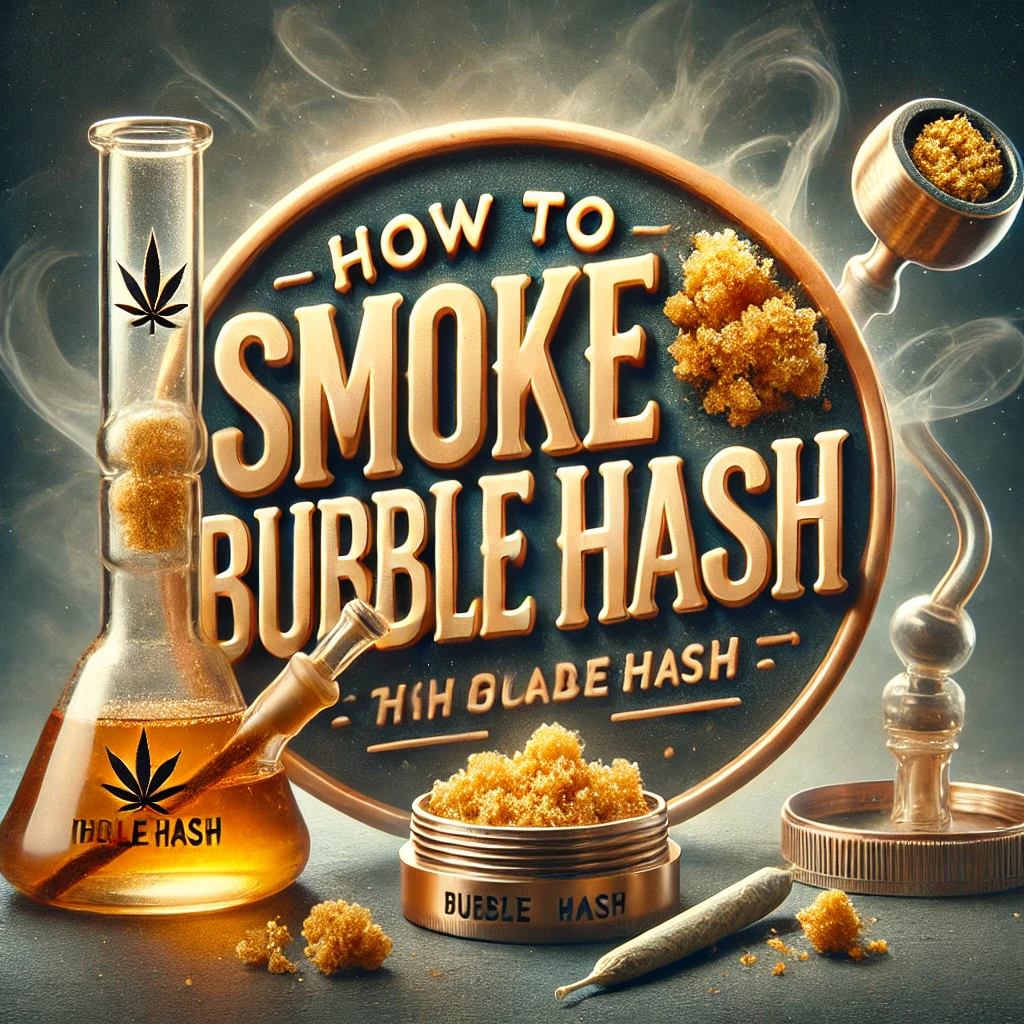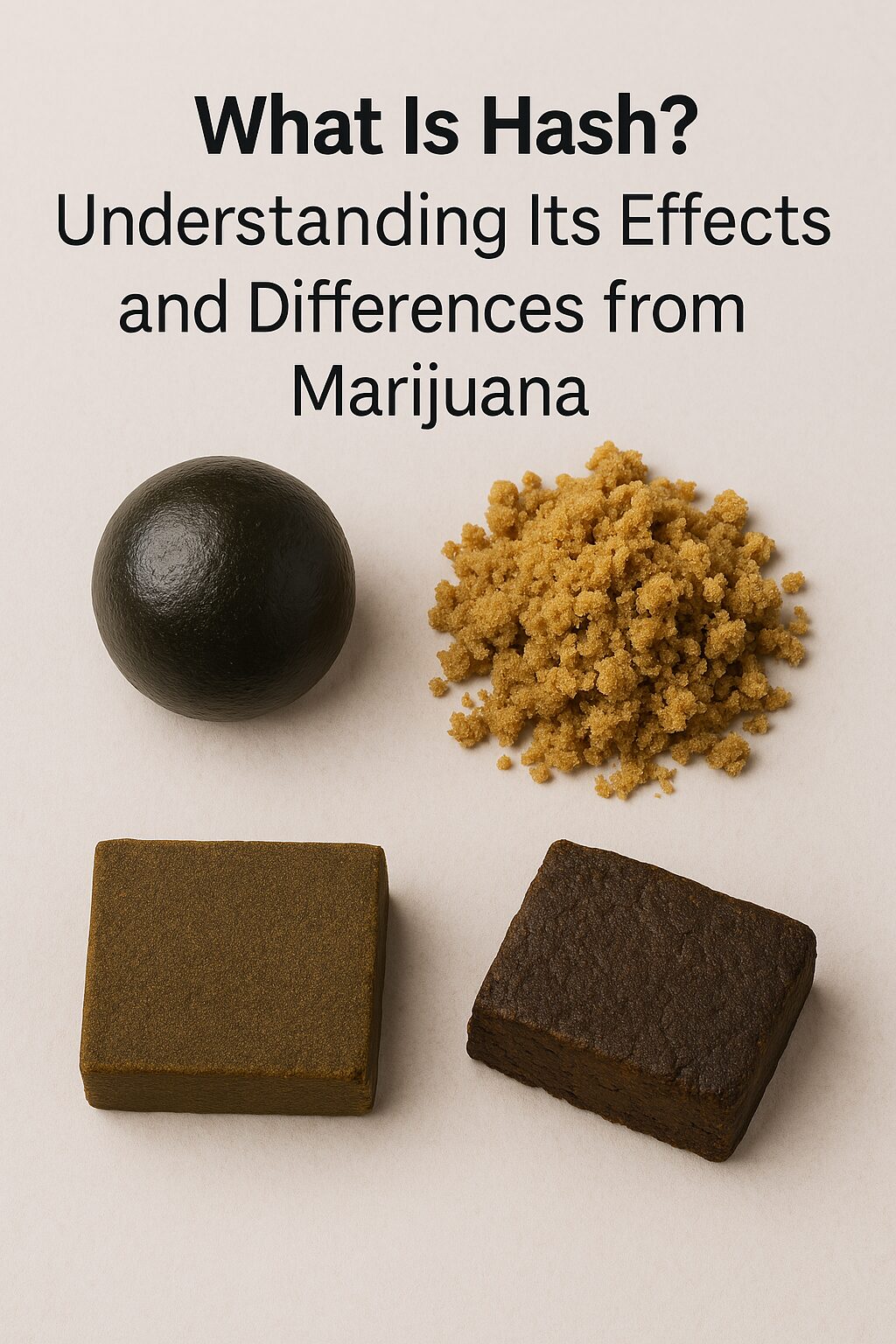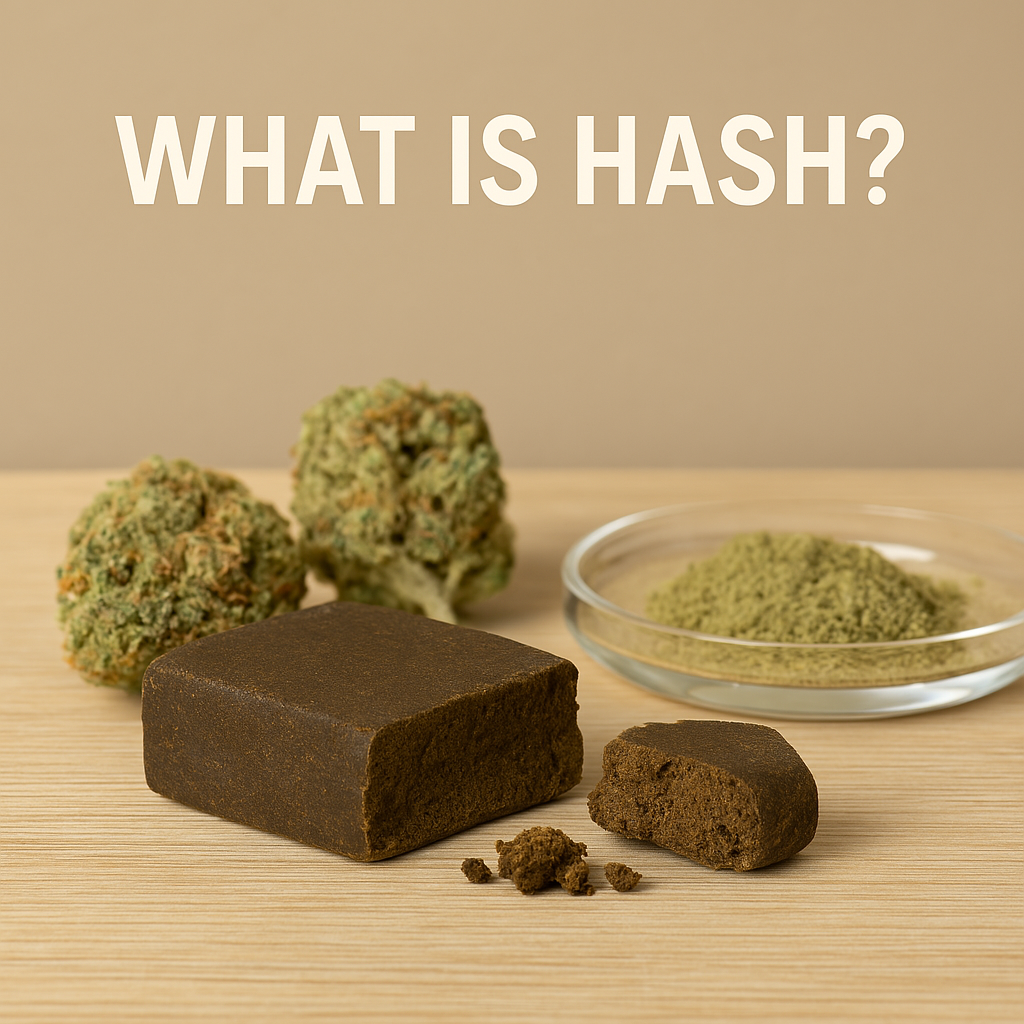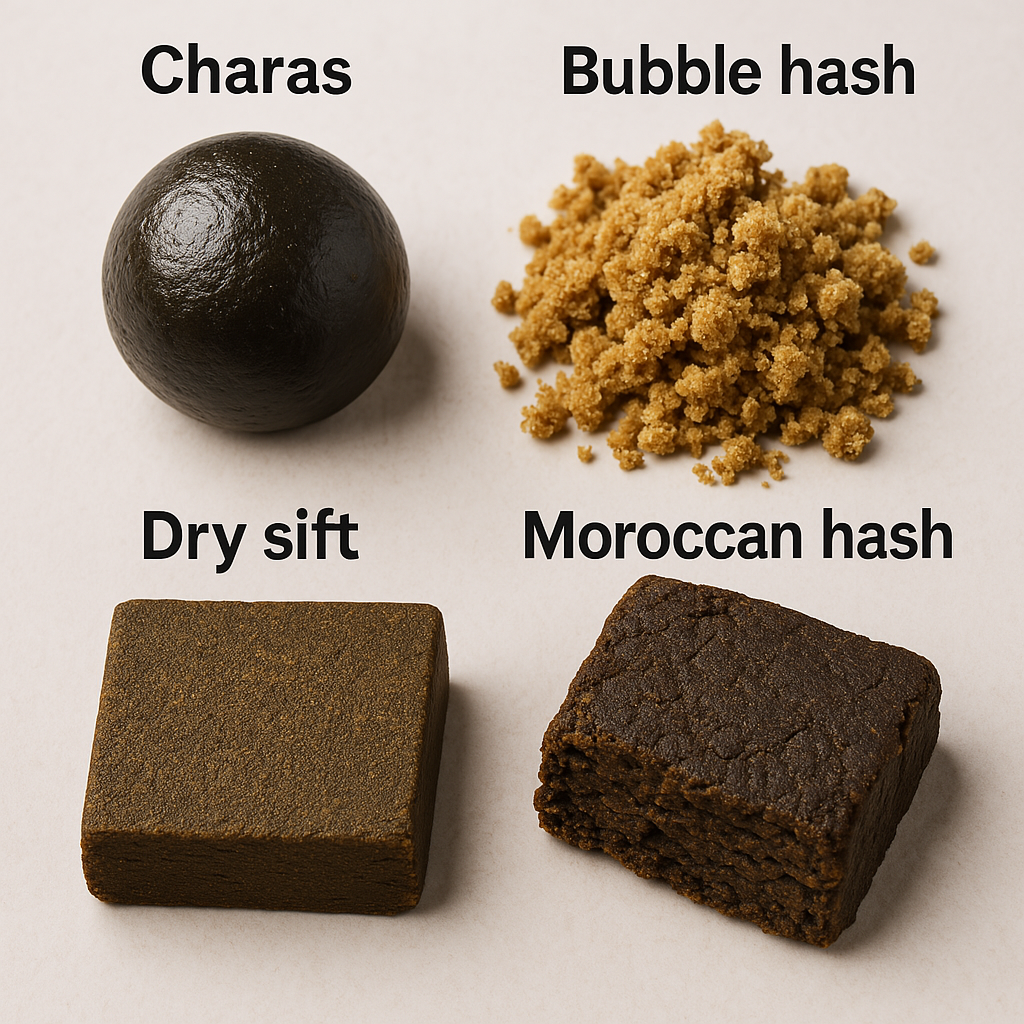

Hash, or hashish, is a concentrated form of cannabis resin known for its high THC content. Unlike marijuana, which consists of dried flowers and leaves, hash is made from the resin glands of the cannabis plant. This article will break down what is hash, its different forms, how it’s made, and how it compares to marijuana, highlighting that hashish can produce the same effects as cannabis.
Hash, or hashish, is a concentrated cannabis product with THC levels ranging from 40% to 80%, significantly higher than marijuana’s average of 20%.
Methods of producing hash include traditional hand-pressing and modern techniques like ice-water extraction and solvent-based extractions, each yielding different textures and potencies.
Hash consumption carries potential health risks, including anxiety, respiratory issues, and the risk of cannabis use disorder, highlighting the need for cautious use and awareness of its effects.
Understanding the effects of hashish use is crucial, as it can lead to potential cognitive impairments and other health risks, especially given the increasing potency of THC in hashish compared to traditional marijuana.

Hash, often referred to as hash hashish, is a concentrated form of cannabis resin known for its high THC content, which can range from 40% to 80%. This makes it significantly more potent than marijuana, which typically contains around 20% THC. Hashish is derived from the resinous trichomes of the cannabis plant, specifically Cannabis sativa or Cannabis indica.
The appearance of hashish can vary depending, but it generally presents as a dark brown to black colored resinous material. Its potency and distinct form make it a popular choice among those seeking a more intense cannabis experience.
Hash is a concentrated form of cannabis made by collecting and compressing the resinous trichomes found on cannabis flowers. These trichomes are tiny crystal-like structures that contain the plant’s cannabinoids (like THC and CBD) and aromatic compounds called terpenes.
Despite the long-held belief that cannabis is a non addictive substance, surprising findings have shown that it can indeed lead to addiction, especially with increased THC levels. This shift in understanding emphasizes the evolving perspective on cannabis use and addiction risk.
Unlike cannabis flower, which is smoked or vaped in its raw form, hash is processed and refined, creating a dense, sticky, and often dark-colored product that’s far more potent than standard bud.
Next, let’s explore the various forms of hash and their production methods.
Hash comes in several forms, each offering unique textures and potency levels. Among the most popular are bubble hash and hash oil. Bubble hash is created using ice water to separate the trichomes from the plant material, producing a product that is rich in cannabinoids and terpenes. Hash oil, on the other hand, is a concentrated form of hash extracted using solvents, resulting in a highly potent product that is often used for dabbing. Additionally, hash oils and waxes are derivatives produced using solvents, known for their powerful psychoactive effects and potency compared to traditional marijuana. However, the variability in potency and safety concerns in production highlight the risks associated with these products.
On the streets, hash is known by various street names, commonly referred to as boom, gangster, hemp, and simply hash. It is typically sold in small blocks or chunks, each form catering to different preferences and consumption methods. These variations in form and potency allow users to choose the type of hash that best suits their needs and desired effects.
The history of marijuana products stretches back thousands of years, with evidence of their use found in ancient civilizations such as China, Egypt, and Greece. These early societies utilized marijuana for a variety of purposes, including medicinal, spiritual, and recreational activities. The cannabis plant, from which marijuana products are derived, contains over 400 chemical compounds, with THC being the primary psychoactive ingredient responsible for the plant’s mind-altering effects.
Hash oil, a concentrated form of cannabis, is produced through various methods, including solvent-based extraction and mechanical separation. The manufacturing process of marijuana products, including hashish, involves collecting the resinous trichomes from the cannabis plant. These trichomes are then compressed or purified to produce the final product, which can vary greatly in quality and potency depending on factors such as the cannabis strain, growing conditions, and the specific manufacturing process used.
Marijuana products, including hashish, can be consumed in several ways, such as smoking, vaping, and ingestion. The effects of these products can vary depending on the individual, with some experiencing altered perception, heightened sensory perception, and increased appetite. The cannabis sativa plant, from which these products are derived, is a versatile crop that can be used to produce a variety of items, including food, fiber, and medicine.
The history and manufacturing of marijuana products are complex and multifaceted, with a rich cultural and social context that continues to evolve today. As the legal landscape around cannabis changes, the methods of production and the variety of products available continue to expand, offering new and exciting ways for people to experience the benefits of this ancient plant.

Hash production can be traced back to ancient techniques, such as hand-rolling, still in use today. Traditional methods like hand-pressing involve manually compressing the resinous trichomes called trichomes from the cannabis plant. This process can yield a product with varying textures and potencies, depending on the skill and methods employed.
Modern methods have introduced more refined techniques, such as ice-water extraction and the use of dry ice. Bubble hash, produced through ice-water extraction, involves stirring cannabis in iced water, causing the resin glands to detach and be collected. Another method involves using dry ice, which helps preserve the terpenes while effectively separating the trichomes from the plant material.
Hash oil is another popular form, created by extracting cannabinoids using solvents like butane or ethanol. This method results in a highly concentrated product that is often used for dabbing. Honey oil, a type of cannabis concentrate obtained through chemical separation methods, dissolves desirable resins from the cannabis plant, leaving behind purer extracts. Mechanical tumbling devices can also automate the extraction process, making it easier to collect kief from cannabis buds. These diverse production methods cater to various preferences, allowing users to select their preferred type of hash oils.
Hash can be made in several ways, but the core principle is always the same — separating the sticky resin, which refers to the resinous trichomes collected from the cannabis plant's flowers and leaves, from the rest of the plant material and pressing them together.
Classic hash is often created by hand-rubbing cannabis plants until the resin collects on the hands, then rolling it into sticky balls or slabs. This method is popular in regions like Afghanistan, India, and Nepal.
These regions have a long history of traditional hash-making methods, tracing back centuries to ancient practices.
Today, hash can also be produced using dry-sifting screens or ice-water extraction, which collects trichomes through gentle agitation. These techniques create cleaner, more refined hash with minimal plant matter.
No matter the method, the result is a marijuana concentrate with high levels of THC and other cannabinoids.
Hashish and marijuana, while both derived from cannabis plants, differ significantly in composition and effects. Hash is made from the resin glands, known as trichomes, of the cannabis plant, whereas marijuana consists of dried flowers and leaves. This distinction results in hash having a much higher THC concentration, ranging from 40% to 80%, compared to marijuana’s average of 20%.
With its higher THC concentration, hash delivers stronger psychoactive effects compared to marijuana. Users often encounter more intense psychotropic effects, such as altered perceptions and heightened sensory experiences, due to hash’s increased potency.
The legal regulations and effects of recreational use of hash and marijuana vary significantly across different U.S. states. Understanding state laws regarding both recreational and medical marijuana is crucial for consumer safety, as the potency and potential risks associated with varying consumption methods can differ.
The concentrated nature of hash results in more pronounced effects, which can be both appealing and risky for users. While its marijuana potency makes hash appealing for a stronger cannabis experience, it requires caution, particularly for new users, especially when consumed in larger quantities and higher concentrations. The active ingredients in hash contribute to its strength and effects.

Hash can be consumed in various ways, offering flexibility to users. One of the most common methods is smoking, where hash can be added to joints, pipes, or a water pipe. Each device offers a different experience, with water pipes often providing a smoother inhalation. It is also common to combine hash with tobacco for smoking, as hash alone can burn poorly.
Dabbing, another popular method, involves heating hash oil on a surface like a nail and inhaling the vapor with a specialized tool.
Ingesting hash by adding it to food results in a slower onset of effects but often leads to a more prolonged high. These consumption methods cater to various preferences, making hash a versatile option for cannabis use.
Hash, short for hashish, has been a prized cannabis concentrate for centuries. Known for its rich history and powerful effects, hash continues to hold a special place among cannabis enthusiasts around the world. But what is hash exactly, and how does it differ from regular marijuana or cannabis flower? Hash serves both recreational and medicinal purposes, catering to a diverse range of users.
In this guide, we’ll break down everything you need to know about hash — from how it’s made to its distinct effects and how it compares to traditional cannabis.
The effects of hash are typically more intense and longer-lasting than those of cannabis flower. Since hash contains higher concentrations of THC, users often report a stronger body and cerebral high.
The short-term effects of hash use can include memory problems, distorted perception, and increased anxiety. These effects can be severe and may require emergency medical treatment, particularly when individuals have pre-existing health conditions or consume hash products contaminated with harmful substances.
Deep physical relaxation
Uplifting mental euphoria
Heightened sensory awareness
Sedation or couch-lock (with higher doses)
Relief from stress, pain, and insomnia
Increased anxiety and panic attacks due to high concentration of THC
The specific effects can vary depending on the cannabis strain used to produce the hash. For example, indica-based hash may feel calming and sedating, while sativa-based hash might provide an energetic and uplifting experience.
The long-term effects of marijuana use, including hashish, can be significant and far-reaching, impacting both physical and mental health. Chronic marijuana use has been linked to an increased risk of chronic bronchitis, lung infections, and other respiratory problems. These issues arise from the inhalation of smoke, which can irritate the lungs and lead to long-term damage.
Marijuana use can also have negative effects on mental health, including an increased risk of anxiety, depression, and amotivational syndrome. The brain’s reward system can be affected by long-term marijuana use, leading to constant cravings and a loss of interest in other essential life activities. Cognitive functions such as problem-solving and memory can also be impaired, particularly in heavy or frequent users.
The risk of developing cannabis use disorder, a condition characterized by compulsive use despite negative consequences, is higher among those who use marijuana heavily or frequently. Long-term marijuana use can also lead to increased blood pressure, which can elevate the risk of heart disease and other cardiovascular problems.
The effects of marijuana use on reproductive health are not fully understood, but some studies suggest that it may impact fertility and fetal development. Additionally, marijuana use can have negative effects on relationships and daily life, including decreased productivity and an increased risk of accidents and injuries.
Seeking treatment for marijuana use disorder is an important step towards recovery. Treatment can involve a range of therapies and support services designed to help individuals overcome their dependence on marijuana and improve their overall quality of life. Understanding the long-term effects of marijuana use is crucial for making informed decisions about cannabis consumption and seeking help when needed.
While both hash and marijuana come from the cannabis plant, they offer very different experiences due to their composition and potency.
Cannabis is classified as a Schedule 1 drug under federal law, which has significant implications for its regulation and consumption.
Hash is much more concentrated than cannabis flower, with high concentrations of THC found in hash. While typical marijuana strains have THC levels ranging from 15% to 25%, hash can contain THC levels of 40% to 60% or even higher in some cases.
Marijuana is the dried flower of the cannabis plant, while hash appears as a dense, resinous material that can be soft and pliable or hard and brittle, depending on its preparation. Consuming hash may enhance sensory experiences, leading to alterations in visual perception and an intensified appreciation of brighter colors.
Hash can be consumed in several ways:
Crumbled into joints or bowls with flower
Vaporized in hash-specific vaporizers
Dabbed using specialized rigs
Pressed into edibles or tinctures
Mixed with other substances, which can amplify health risks and complicate the effects, especially when unregulated or harmful additives are involved
While hash and marijuana both come from the cannabis plant, their appearance, potency, texture, and consumption methods set them apart in many ways. To fully understand how hash differs from marijuana, it’s important to look at how each is made and how it delivers its effects.
Marijuana, often referred to as cannabis flower or bud, is the dried and cured part of the cannabis plant that is commonly smoked or vaped. It contains the full range of the plant’s compounds — including cannabinoids like THC and CBD, along with aromatic terpenes. Marijuana is usually consumed in its natural form, either ground up for smoking or vaporizing, or infused into oils and edibles.
Hash, short for hashish, is a concentrated form of cannabis that is created by collecting and compressing the plant’s trichomes. These trichomes are tiny, crystal-like structures that cover the cannabis flower and contain the highest concentration of THC, CBD, and other cannabinoids. Hash is essentially a purified and condensed form of cannabis resin, which makes it much more potent than regular marijuana flower.
One of the most noticeable differences between hash and marijuana is their appearance and texture. Marijuana is typically green or purple with visible buds, while hash is usually brown, golden, or black in color with a soft, crumbly, or sometimes sticky texture depending on how it’s made. Hash can come in a variety of forms, such as pressed blocks, balls, or slabs, unlike the leafy and fluffy appearance of cannabis buds.
Hash also provides a different smoking or consumption experience compared to marijuana. Because hash is more concentrated, it often delivers a stronger, faster-acting high with a smaller amount required. This potency appeals to experienced users or those looking for a more intense or long-lasting effect. The flavor profile of hash also tends to be richer, deeper, and earthier due to the concentrated terpenes.
Another major difference lies in the method of production. While marijuana involves harvesting and curing the cannabis plant, hash requires an additional extraction process to separate the trichomes from the plant material. Traditional methods involve hand-rolling, sieving, or using ice water to extract the resin. Modern methods may involve mechanical separation or solvent-based extraction, but the result is always a highly concentrated product.
Finally, the effects of hash and marijuana, while similar in terms of relaxation and euphoria, can differ in their intensity and duration. Hash often delivers a more sedative and body-heavy high due to its concentrated nature, making it popular for evening use or for those seeking strong relief from stress, insomnia, or chronic pain.
In summary, hash and marijuana may originate from the same plant, but their differences in potency, preparation, appearance, and effects give each its own unique identity within cannabis culture. While marijuana offers a more familiar and versatile smoking experience, hash provides a powerful, flavorful, and historically rich alternative that many cannabis enthusiasts deeply appreciate.
For many, hash offers a nostalgic connection to traditional cannabis culture while also delivering a powerful, clean high. Its potency means users can enjoy smaller amounts while still experiencing deep relaxation and euphoria.
Additionally, hash’s distinct flavor profile — earthy, spicy, and often rich in terpenes — adds an extra layer of enjoyment for connoisseurs.
Hash has earned its reputation as a beloved cannabis concentrate for good reason. For many enthusiasts, it offers a truly unique and nostalgic experience that sets it apart from other forms of cannabis. Its rich history, traditional production methods, and distinct effects have created a loyal following that continues to grow — even as modern concentrates like shatter and live resin gain popularity.
One of the main reasons people love hash is its undeniable potency. Because hash is created by isolating and compressing trichomes — the part of the cannabis plant that contains the highest concentration of cannabinoids and terpenes — it delivers a powerful and longer-lasting high with much less product compared to regular cannabis flower. This makes hash not only cost-effective for many users but also incredibly efficient for those seeking a stronger experience.
However, it is important to note that hash use can increase the risk of mental health conditions like schizophrenia in vulnerable individuals. The substance can alter an individual's mental state and exacerbate issues such as anxiety and depression, especially among those already at risk.
In addition to potency, hash offers a unique flavor profile that is often described as earthy, spicy, and slightly sweet. This distinctive taste comes from the terpenes preserved during the extraction process. For true cannabis connoisseurs, the rich, full-bodied aroma and flavor of hash provide a more refined and traditional smoking experience that can’t quite be replicated by other concentrates or even fresh flower.
Another factor that draws users to hash is its versatility. Hash can be smoked on its own, crumbled into a joint or bowl, vaped, or even infused into edibles. Its adaptable nature allows users to experiment and find their preferred method of consumption, making it suitable for both beginners and seasoned cannabis lovers.
Finally, hash is loved for its connection to cannabis culture and history. Originating from regions like Morocco, Afghanistan, and Nepal, hash has been handcrafted and enjoyed for centuries. Many cannabis users appreciate the traditional craftsmanship and artistry that goes into making high-quality hash, viewing it not just as a product but as a legacy of cannabis heritage.
In a world where cannabis products are constantly evolving, hash remains a timeless classic. Its potency, flavor, versatility, and deep cultural roots all contribute to why it continues to be cherished by cannabis enthusiasts around the world. Whether it’s the nostalgia of traditional hash or the desire for a strong, clean high, hash offers an experience that’s both memorable and truly one-of-a-kind.
If you’re seeking a more potent cannabis experience with rich flavor and heritage behind it, hash is definitely worth exploring. It’s a versatile concentrate that allows both new and experienced cannabis users to experience cannabis in a new and exciting way. Hash has been used for both recreational purposes and medicinal purposes throughout history, highlighting its diverse applications.
Whether you enjoy classic hand-pressed hash or modern ice-water extracts, hash remains one of the most celebrated cannabis concentrates for a reason.
Looking to experience premium hash for yourself? Explore the wide selection of quality hash products available at Hash Online Canada and discover why this ancient cannabis concentrate continues to stand the test of time.
Sometimes it’s nice to put in text just to get an idea of how text will fill in a space on your website.
Who We Are
Welcome to Hash Online Canada, your trusted destination in the heart of Canada’s thriving cannabis market. We’re proud to deliver premium hash products that combine exceptional quality with unbeatable value.
Contact Us
Have questions or need help? Our expert team is here for you. Whether you're looking for product information or personalized advice, we’re ready to assist. Reach out to us today with any inquiries!
Email: [email protected]